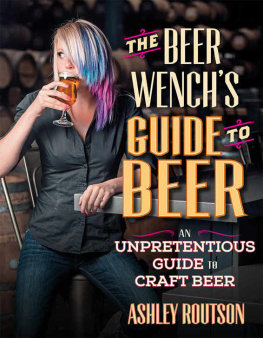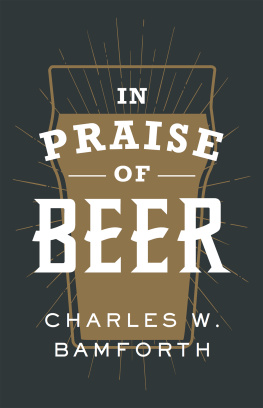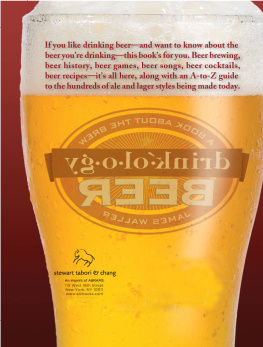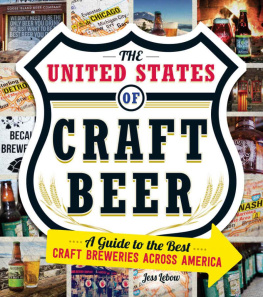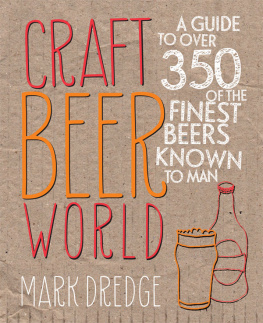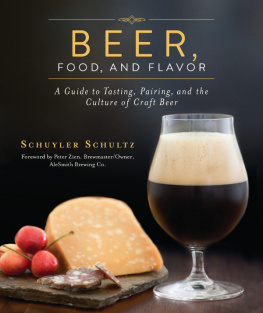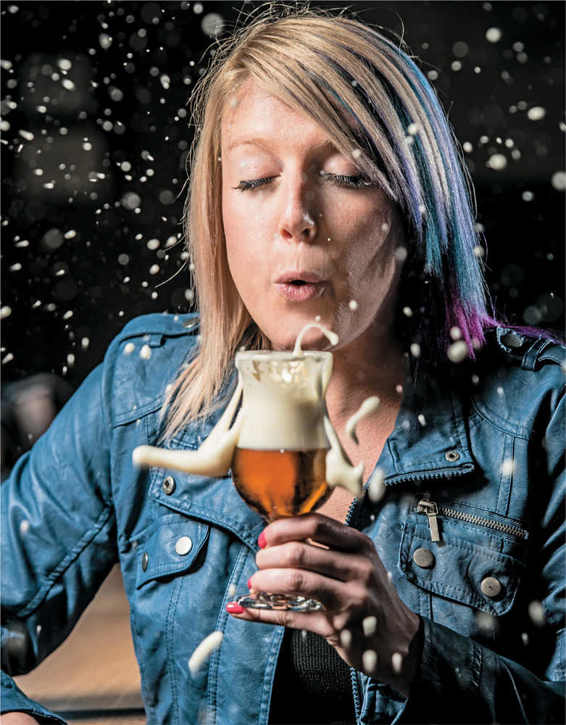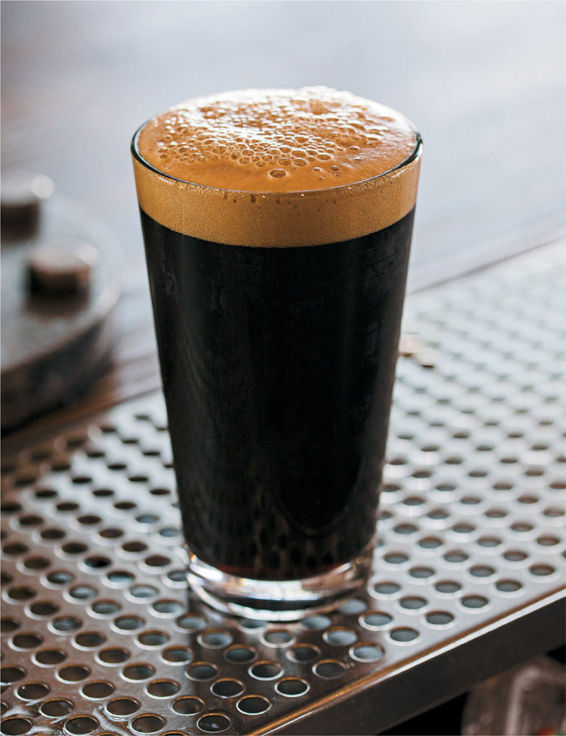THE BEER WENCHS
GUIDE TO BEER
AN
UNPRETENTIOUS GUIDE TO CRAFT BEER
ASHLEY ROUTSON

CONTENTS
INTRODUCTION
When you think about it, learning about beer is similar to dating, or even just getting to know a new person. The first thing you notice are all the physical traits. For beer, that starts with the color, the vessel in which its served, and the amount of foam and head retention. But then you move inoh, the aroma! You just have to take a sip. Then, the all-important attribute: the flavor.
When youre infatuated with beer, you start to dig a little deeper. There are fun details to unearth as you figure out what you likethe alcohol level, the bitterness, and maybe even a little bit about the history of the style. Who knew history could be so fun? Once you spend enough time hanging out with beer, understanding her little nuances, you fall in love.
So she takes you home, to the brewery, where she shows you where she came from and how she was made. She lets you meet her parents (water, yeast, malt, and hops) and tells you how to take care of her (she is a fickle little thing). Now you cant imagine your life without her. Youre cooking together and drinking together every week.
OK, maybe that was a little bit of a stretch, but it does explain my particular approach to writing this book. First, were going to walk through many of the beer styles youll find today. Well learn the defining factors of each style, some science-y numbers to impress your friends, a little bit about the history of how these styles came to be, and tasting notes that will help you know what to expect from each style. Youll learn what beers you like, what beers you dont like, and just as important, why you feel the way you do.
The second section, Becoming an Expert, contains a description of the brewing process, the ingredients used in brewing, and how to properly store and serve beer. While that might sound dry, its anything but. Playing with glassware and learning how to taste beer is all sorts of nerdy fun. And if youve ever wondered what goes into making beeror if you just want to be better at pub triviathis section is not to be skipped.
Last, but certainly not least, well have some fun with beer. (In fact, feel free to skip straight to this section if its where you want to start.) Well learn all about beer pairingswith plenty of cheese, of course. Well cook with beer, making everything from breakfast to dinner and dessert. Well even make blends and cocktails with beer, from the classic Black and Tan to my signature Beermosa. Oh, and if you just rolled your eyes or made a face at the thought of using beer in cocktails, just wait. I will convert you.
What are we waiting for? Lets get started.
SECTION
ONE
WHAT DID I JUST DRINK?
A Guide to Beer Styles (and History!)
chapter one
BREAKING DOWN BEER STYLES
In the past, beer books and other so-called official sources have traditionally organized beer styles by country or region. Ive taken a different approach and created a guide that relates to the way most people actually drink. For example, if you already know you like hoppy beers, you can jump straight to the IPA or Other Hoppy Beers chapters. If you love malty and dark beers, its clear which chapters are for you as well. I hope that means you can easily flip through and figure out exactly where you want to start reading (and sampling, of course!).
The exception to this is the Belgian beer chapter. Since those styles are so unique, and their signature flavors are largely determined by particular Belgian yeasts, they really belong together rather than mixed among the other chapters. Also, Ive found that even though the beers have a wide range of flavors, many beer drinkers either fall in love with almost all of them or none at all.
Its important to note that some beer styles might have been not-so-accidentally left out and some not-exactly-recognized-yet beer styles might have been thrown into the mix. Some styles also get a ton of attention, while others barely get a mention. What can I say? The beer world is ever expanding and our collective attention span is ever diminishing. And this is my book so I get to play favorites, right?
So heres what will happen: Ill start each section with some general notes to provide some context and some backstory behind the styles that follow, then dive into a handful of specific beers. Once you get into the beers, the entries will contain the same parts to make an apples-to-apples, or should I say beer-to-beer, comparison as easy as could be:
Style name: This is pretty self-explanatory.
The gist: Youll find this in italics right under the style name. Its a 140-character or less description of the style, so its perfect for skimming and tweeting while reading (hint hint).
My two cents: This is where things get fun. How does it look, smell, and taste? Pour one for yourself and compare notes with me. Since some styles are more dynamic than others, some descriptions may be a little wackier than others. Keep in mind that this section is somewhat based on the style standards, but it is more than a bit subjective. Its the beer style as seen through the eyes of the wench. If a particular description gets you excited, and you want a full-on download of straight style knowledge, the websites for both the Brewers Association (www.brewersassociation.org) and the Beer Judge Certification Program (BJCP, www.bjcp.org) have links to the most up-to-date style guidelines that both organizations use for judging beer competitions.
Key stats:
Standard Reference Method (SRM): SRM is one of the most common ways that beer pros determine the color of a beer. Im not going to tell you how its scientifically determined; its complicated and way above my head. However, whether youre a brewer, beer judge, or beer drinker, you can easily reference a set of swatches to figure out where the beer in your hand falls on the scale. If you dont have a set of swatches handy, remember the lower the SRM number, the lighter the color of the beer. The higher the number, the darker the beer. The highest number is about 40, which is typically reserved for an imperial stout. Ive included the chart at 113.
International Bittering Units (IBU): The IBU scale measures a beers bitterness, most of which comes from the hops, specifically the alpha acids in hops (see ). The scale takes into consideration two key factors: the level of alpha acids in the hop varietal and the length of extraction during the boil. It is important to note that while IBU measures the bitterness in beer, it does not necessarily measure a beers hoppiness. A beer may be high in hop aroma and flavor, yet low in bitterness. There is no official scale for hop aroma or flavor, only subjective observations.
The IBU Scale: This technically ranges from 0 to 100, but most beer styles fall between 20 and 45 IBUs. Some styles, like lighter lagers, gruits (hopless beers), and sour beers, can fall below 20 IBUs. Other styles, such as big imperial IPAs or aggressive imperial stouts, could hit the 80100 mark.

